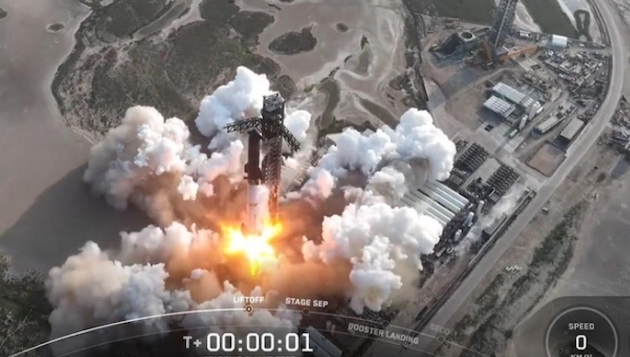Wednesday May 28, 2025|
SpaceX lost control of its massive Starship rocket just 30 minutes into flight on Wednesday, May 28, resulting in the vehicle’s dramatic breakup during reentry into Earth’s atmosphere, as reported.
The incident marked the ninth test flight for the spacecraft designed to carry humans to Mars and beyond.
The mega-rocket then re-entered the atmosphere earlier than planned on Wednesday after an onboard fuel leak triggered uncontrollable spinning in space.
In a post on social media, SpaceX said the Starship experienced a “rapid unscheduled disassembly,” meaning it burst apart.
“With a test like this, success comes from what we learn, and today’s test will help us improve Starship’s reliability as SpaceX seeks to make life multiplanetary,” the company stated.
Standing at 403 feet (123 meters), Starship flew farther than previous test attempts before the failure occurred.
This marks the second major issue this year, following a March launch that ended in an explosion shortly after takeoff.
The latest test launch comes after a SpaceX Starship exploded shortly after takeoff on March 6.
The fallout prompted the US Federal Aviation Administration (FAA) to temporarily halt air traffic at several Florida airports, including Miami International, as debris from the failed spacecraft descended.
The FAA had preemptively expanded the airspace closure zone to 1,600 nautical miles to ensure safety.
Musk has spent billions of dollars on Starship’s development. The South African-born billionaire claims the initiative is part of his commercial space flight company’s plan to colonise the planet Mars. SpaceX is also working with US government agency NASA to return humans to the Moon for the first time in more than 50 years.
However, the frequent failures and growing size of Starship have raised environmental and regulatory concerns. Debris from test flights has been found across the southern United States and as far as the Caribbean.
Before this latest launch, Starship had completed eight integrated test flights on top of its Super Heavy booster launch vehicle, with four successes and four failures ending in explosions
The company is betting that its “fail fast, learn fast” approach will eventually pay off. Still, it acknowledged in a statement that progress “won’t always come in leaps.”
In issuing approval for Tuesday’s test, the FAA said it had nearly doubled the airspace closure zone to 1,600 nautical miles (2,963 km) east of the launch site.
This latest launch required international coordination with aviation authorities in the UK, Mexico, Cuba, the Bahamas, and the British territory of Turks and Caicos.
The FAA also recently approved an increase in annual launches from five to 25, stating that the increased frequency would not adversely affect the environment, and overruling objections from conservation groups.
FAA’s changes come as Musk has played a prominent role in US President Donald Trump’s second administration, claiming to focus his attention on what he describes as “billions, hundreds of millions of dollars of fraud and abuse.”
However, Musk’s large business portfolio’s overlap with the US federal government’s regulatory role has raised questions and criticism. In March, the Campaign Legal Centre (CLC) filed an ethics complaint with the US Department of Transportation’s Office of the Inspector General, requesting an investigation into whether the FAA’s business transactions with Musk’s Starlink satellite communications network violated conflict-of-interest laws.
Related posts
Categories
- Advertisements (1)
- Agriculture (44)
- Breaking News (25)
- Business (583)
- Crime (951)
- Education (304)
- Entertainment (124)
- Features (13)
- For The Records (41)
- Foreign News (1,145)
- Health (210)
- Home News (332)
- Interview (9)
- Judiciary (335)
- Lifestyle (138)
- Local News (111)
- National News (1,411)
- Opinion (26)
- Politics (938)
- Religion (146)
- Science and Technology (120)
- Security (634)
- Sports (833)
- States' News (755)
- Transportation (309)
- Uncategorized (9)

